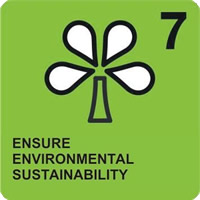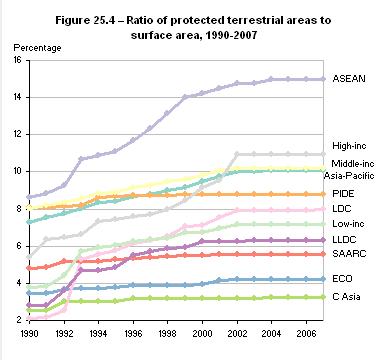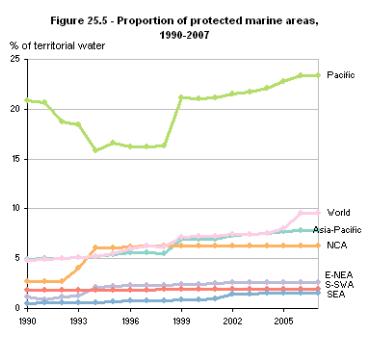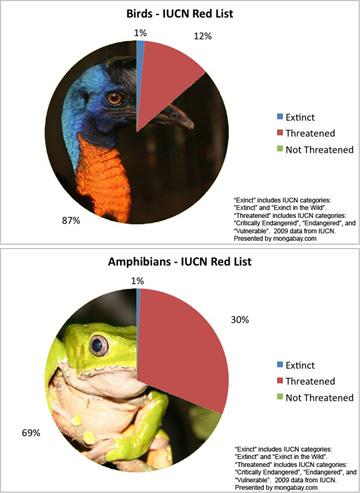User:Vtaylor/CIS2/Summer 2009/Group 3
| Students @ Work - a student collaborative writing project. Help us by providing feedback on the Discussion page. |
CIS 2 Computers and the Internet in Society SUMMER 2009 Final Projects
Goal 7: Ensure Environmental Sustainability
Contents
About UNDP and the Millennium Development Goals
"The UN Millennium Project is an independent advisory body commissioned by the UN Secretary-General to propose the best strategies for meeting the Millennium Development Goals (MDGs). The MDGs are the world’s quantified targets for dramatically reducing extreme poverty in its many dimensions by 2015 – income poverty, hunger, disease, exclusion, lack of infrastructure and shelter – while promoting gender equality, education, health, and environmental sustainability. The UN Millennium Project is directed by Professor Jeffrey D. Sachs, Special Advisor to the Secretary-General on the Millennium Development Goals. The bulk of its analytical work is performed by 10 task forces, each composed of scholars, policymakers, civil society leaders, and private-sector representatives. The UN Millennium Project reports directly to UN Secretary-General Kofi Annan and United Nations Development Program Administrator Mark Malloch Brown, in his capacity as Chair of the UN Development Group"
- excerpt from Millennium Project Report on Environmental Sustainability
Find out more at the United Nations Development Programme website.
Goal 7: Ensure Environmental Sustainability
The purpose of this project is to investigate how computers and technology are contributing to resolving the issues about the environment. For example, how computers are contributing to the changes in how people are dealing with the issues of pollution, loss of biodiversity, toxic water, deforestation, and urban slums. These goals are taken directly from the UNDP targets for Goal 7. Environmental Sustainability affects everyone's livelihood. Computer technology is making a difference aiding the quest for sustainability and creating a more balanced planet.
Target 7a by Renee
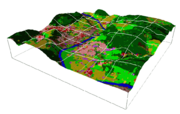
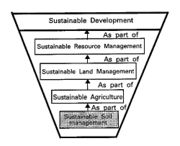
Integrate the principles of sustainable development into country policies and programs; reverse loss of environmental resources
Sustainable development affects every aspect of Goal 7 and all the UN Millennium Goals from addressing poverty and discrimination against women to urban slums and unsafe drinking water. Essentially, the concept of sustainability affects every aspect of a society. The definition provided by the UN explains that environmental sustainability is meeting human needs while taking into account the capacity of the environment to provide for those needs over the long term.10 Essentially, sustainable development is part of agriculture, law, ecology, engineering, architecture, design, urban planning, and even technology.
Sustainable technology shows how computers are helping the environment. Using satellite technology, governments can control the threats of deforestation from behind a computer screen. Solar and wind power contributes to the cutting down of C02 emissions in the atmosphere. Alternative sources of fuel and more sustainable uses of water rely heavily on innovative computer technology. Clean water, a problem in many impoverished countries worldwide, is another one of the UN's goals. From nanotech particles to liquid bleach injection, cleaning up water can prevent many deaths worldwide due to unsafe drinking water. The urban slums could be greatly enhanced with sustainability practices in architecture, urban planning, and design.
The Example of Sustainable Agriculture
Sustainable Agriculture is defined as an integrated system of plant and animal production practices having a site-specific application that will, over the long term not only satisfy human food and fiber needs but enhance the environment and natural resources.11 Working from the ground up beginning with soil management, growing food in a sustainable manner, practicing resource management, sustainable development happens in stages. Technology can help through out each of those stages. For example, Geographic Information Systems, GIS, have been a useful asset in sustainable agriculture aiding in precision farming. In the rain forest and Savannah river basins in Nigeria, GIS technology was able to pinpoint the most suitable places to plant needed crops.12
Keeping in mind sustainable practices is a important to the welfare of everyone. When we make sustainability a priority in legislation, caring for ecosystems, providing people with clean drinking water, and urban living are all affected for the better. Education is the key to integrating sustainable practices in country policies and programs. Teaching everyone about sustainable practices from the children to the legislators can reverse climate change and create viable systems. For example, in Mexico, the government worked on pollution control through tough legislation cutting down on pollution and waste, public involvement making training courses available, and creating knowledge networks to teach others.10 Collaboration between the public and private sector, environmental sustainability can be achieved. Sustainability affects every part of life and the UN advocates that the sustainable principle be part of every UN goal for the millennium.
Target 7b by Kimberly, Evelyn, and Yoori
Reduce biodiversity loss, achieving, by 2010, a significant reduction in the rate of loss
* 7.1 Proportion of land area covered by forest
Much of the deforestation on the planet happens illegally. By using satellite video tracking technology, government agencies can view how much forest is cut and whether or not foresters are cutting down trees illegally. Countries like Brazil have begun to use techniques like the Real Time Deforestation Monitoring System (DETER) to track deforestation. By using this technology in Brazil alone, they have found a 20% decrease in deforestation from 2007. 17
* 7.2 CO2 emissions, total, per capita and per $1 GDP (PPP)
CO2 emissions have a devastating impact on the environment. They pollute the air we breathe, creating health problems for humans, animals, and plants. CO2 emissions are known as one of the top contributors to the greenhouse effect which has led to increased global warming. Per capita CO2 emissions remain the highest in developed countries with about 12 metric tons per person per year.[2]
Renewable Energy
Perhaps one of the most beneficial and economical ways to cut down on our CO2 emissions is to use energy alternatives to petroleum and coal fired power plants. Technology has allowed us to create clean, renewable energy in the forms of solar and wind. Solar panels may be installed on homes and businesses to supply a majority of the electricity needed for little or no cost safely with no pollution. [18] Wind energy is widely available throughout the world and is a very simple way to harness substantial amounts of electricity [18]
Alternative Fuel
For every one gallon of gas used, 19 pound of CO2 is introduced into the atmosphere. [19] With our world economy dependent on the use of oil, alternative fuels are becoming increasingly popular. Hybrid cars run off of both electricity and gasoline, creating cleaner energy with better overall efficiency. With the use of Regenerative Braking, hybrid cars do not need to be plugged in to a source of electricity because whenever the car brakes, the battery is capable of recharging itself. Hybrid cars use computing mechanisms to communicate to the driver how the gasoline or electricity from the battery is being used to move the car. [20]
Another popular alternative fuel is hydrogen. Although there are some challenges with using hydrogen including pricing and storing, hydrogen has been proven to be a very clean technology. Hydrogen cars emit only a small amount of heat and clean water (about one gallon per seventy miles) with absolutely no CO2 emissions. [21]
* 7.3 Consumption of ozone-depleting substances
Ozone depleting substances (ODSs) have been proven to impact the environment. The harmful substances have contributed largely to a rise in sun cancer rates around the world. The Montreal Protocol of 1987 established by the Vienna Convention created an international effort to the halt of use ozone depleting substances. Chlorofluorocarbons, halons, carbon tetrachloride and others will be "phased out" from 2015 to 2040. The use of chlorofluorocarbons (CFCs) reduced quickly since 1995 from 185,290 ODP tons to 89,585 ODP tons in 2002. With new technology and research, these products are being less widely used by industry around the world. [26]
Alternative Substances
With the United States Clean Air Act, Environmental Protection Agency scientists began to research alternatives to ozone depleting substances. The EPA program SNAP, Significant New Alternatives Policy, has contributed research in alternatives to the usage of ozone depleting substances like CFCs. The SNAP program has created alternatives for several industrial products like refrigerants and aerosols.[27]
* 7.4 Proportion of fish stocks within safe biological limits
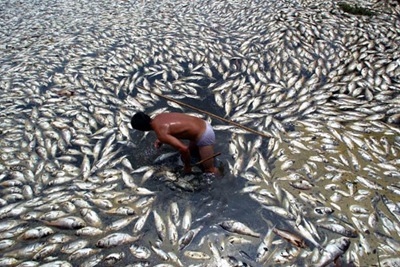
Exploited fish stocks had increased from 70 % in 1995 to 80% in 2006. A higher level of precaution is needed to manage fishery resources due to the uncertainty of the climate change that has an impact on resources and ecosystems. 1 In the Black Sea no stocks are assessed however in the NE Atlantic, commercial fish stocks are assessed about one third are outside safe biological limits in the NE Atlantic. And about half of the assessed stocks are fished outside safe biological limits in the Mediterranean.14 Fish are essential to the ocean's web of life. However, overfishing had decreased fish population where even fishermen aren't able to make a living as a fishermen. Bottom trawling, which involves dragging huge, heavy nets along the sea floor destroying and crashing the deep seas where millions of species are yet to be discovered. 24
Prevention of overfishing
As technology has improved to give abilities to understand the ecosystems in which fish live and the effects humans have on them. Patrolling fisheries protection vessels or aircraft and policing of fishing grounds can also help prevent pirate fishing by being able to identify individual fishing vessels and prove that they are fishing legally. Also modifying fishing gear that helps non-target species to escape or few non-target species are caught. 24 These modifying gears are easy to imply and inexpensive, which also helps non-target species' survival are significantly improved. 23
* 7.5 Proportion of total water resources used

Water resources are used in various of ways such as; direct consumption, agricultural irrigation, fisheries, hydro-power, industrial production, recreation, navigation, environmental protection, the disposal and treatment of sewage, and industrial effluents.5 About 70% of water withdrawn for agriculture around the world and in some regions more than 80% are withdrawn for agriculture. When more than 75% of river flows are diverted for agriculture, industrial, and municipal purposes; human and environmental needs of water will be shortened and lacked.1
More efficient way of agriculture water use
There are many technologies that can significantly reduce the impact of agricultural activities on water resources. Resourceful application of irrigation water use is important to lessen any effects that increased biofuels production may have on water resources. One of the irrigation techniques that reduce the amount of water applied per unit of biomass produced is subsurface drip irrigation systems, which minimize the amount of water lost due to evaporation and runoff by being buried directly beneath the crop and applying water directly to the root zone while keeping the soil surface dry and improving irrigation efficiency regardless of crop type. Real-time soil moisture and weather monitoring, the former through microwave remote sensing, are emerging technologies that can potentially help improve the scheduling of irrigation. 22
* 7.6 Proportion of terrestrial and marine areas protected
One of the best ways to maintain forests and other important ecological resources is to designate them as protected areas. Between 1990 and 2007 the increase in terrestrial areas protected was some 3 per cent. The overall protected marine areas as adopted by the International Union for Conservation of Nature. Media:Example.ogg
* 7.7 Proportion of species threatened with extinction
Nearly 17,000 plant and animal species are known to be threatened with extinction, while more than 800 have disappeared over the past 500 years, reports the International Union for Conservation of Nature (IUCN). The group warns that governments will miss their 2010 target for reducing biodiversity loss.
One in eight of the world's birds faces extinction while all taxonomic groups are under threat.
The Effect Global Warming Has on Animals
Many different species of animals are being effected by global warming, they’re mating, breeding and feeding patterns are being thrown off balance and this can result in death for many animals. For example polar bears hunt and live in polar ice caps, however due to global warming these polar ice caps are melting and getting weaker, and soon it will be all gone. Polar bears would no longer have a place to live.
Target 7c by Michael
Reduce by half the proportion of people without sustainable access to safe drinking water and basic sanitation
* 7.8 Proportion of population using an improved drinking water source
Most people living without improved drinking water sources live in rural areas.1 In 1990, an estimated 77 per cent of the world’s population had access to an improved drinking water source. By 2002 this had increased to 83 per cent. At the time this was considered as being on target for meeting the 2015 goal. However, the global financial crisis beginning in 2007 has slowed the progress of developing improved drinking water and sanitation for those in need, putting the countries involved behind schedule as of 2009.2
Examples of technology used to provide clean water
Liquid chlorine bleach injection device – this device injects a measured amount of chlorine bleach into a pipe through which water is flowing. It has several advantages: it uses no electricity, which is important because many areas without clean drinking water have intermittent electricity or none at all. The system is also able to automatically adjust the amount of chlorine injected based on the amount of water flowing through the pipe. The chlorine bleach used is readily available as liquid laundry bleach – this is important since specialized chemicals would not be available in rural areas of developing countries. This is a mechanical, non-computerized device.6
Nanotech particles – removal of contaminants in water could be achieved through the use of particles made from silica coated with a nanometer thick active material based on a hydrocarbon and an anchor containing silicon. The manufacturing process would simply be to stir the different ingredients together, where they would self-assemble. The active particles are then stirred into the water for up to one hour, and the powder is filtered out. Testing has been done on the active particles to show that they can remove viruses, bacteria, and parasites. The removal of contaminants is due to an electrostatic attraction between the active particles and the various pathogens.7
Water quality modeling tools – There are various programs for measuring different aspects of water pollution, flow, and management. The U.S. Environmental Protection Agency offers a list and links to many water modeling programs. Geographic Information Systems (GIS) is another way to examine and map the relationship between different types of data from various sources. These tools can provide valuable aids in data collection, analysis, and the planning and monitoring of water and sanitation projects. GIS can be used by anyone with general computer skills. GIS also provides a valuable training and awareness opportunity. For example, a high school teacher and his students identified six locations for wells that would provide water to a maximum amount of people in a water deprived area.8
Social Impact of Lack of Improved Water Supply
Lack of access to improved drinking water mostly affects the female population. In most areas where wells or other improved water sources are lacking, it is nearly always the women and young girls who must carry it long distances, often making many trips back and forth carrying jars that weigh 30 to 40 pounds on their heads. Men generally do not participate in the job of fetching water for daily use. The other aspect of the water supplies effect on women in the developing world is that it prevents young women from going to school. Once a girl begins menstruating, she will not be allowed to attend school unless the school has separate facilities for her to practice proper hygiene. Providing easy access to clean water can have a major effect on women in the developing world, providing the opportunity to gain an education and preserve their physical health, along with the other important water related health benefits shared by the whole community.9
* 7.9 Proportion of population using an improved sanitation facility
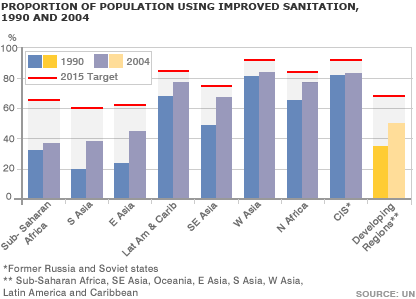
“Rapid acceleration of progress is needed to bring improved sanitation to the 1.4 billion people who were doing without in 2006, with all its attendant consequences for the health of communities and the local environment. At the present rate of progress, the 2015 sanitation target will be missed."
-Sha Zukang, Under-Secretary-General for Department of Economic and Social Affairs (United Nations)2
As of 2006, 2.5 billion people live without access to adequate sanitation. This is nearly half of the developing world’s population.3 Although 1.1 billion people gained access to latrines and toilets or other forms of improved sanitation between 1990 and 2006, another 1.4 billion will need them if the 2015 goal is to be met.1
Technology in Sanitation
Although in developed countries sanitation control facilities are high tech computer controlled systems, in the developing world there is often no reliable infrastructure, and the rural locations in need of improved sanitation means the development of these systems is not a feasible option.1 Most of the technology involved in constructing latrines for villages involves shovels or other digging implements, along with lumber, nails and some cement. As with clean water development, Geographic Information Systems could be useful in assessing, developing, and monitoring solutions to sanitation problems.
Target 7d by Ying
Achieve significant improvement in lives of at least 100 million slum dwellers, by 2020
* 7.10 Proportion of urban population living in slums
General Information
Although the lives people in slum have been improved a lot in almost everywhere in the world, the housing and electricity still slow down the process of development.29 According to the following map, most of the slum dweller live in Africa, Southern and Western Asia. Helping people in slum to have access to sanitation is one the the goals of MDG (Millennium Development Goals).
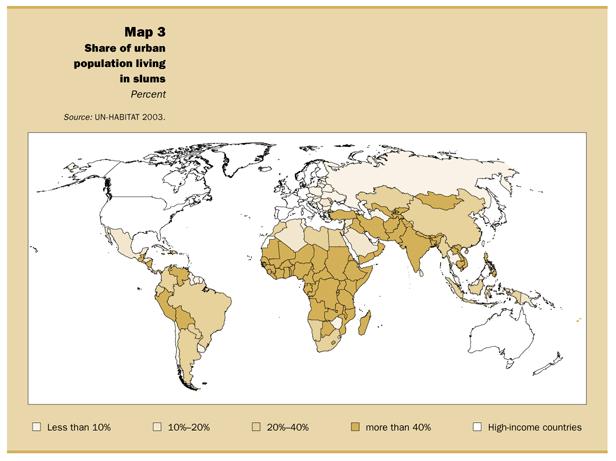
Slum in three major regions
- Eastern Asia
Improved access to both water and sanitation help reducing the proportion of slum in China as well as India and other Southern Asia regions.29
- sub-Saharan Africa
Africa still has the highest proportion of slum. The slums grow as rapidly as the urban areas in this region. Therefore, large investment are needed on improvement of this region.
- Wester Asia
Because of the living conditions in this region is decreasing, the proportion of urban slums has slight increased. The political instability in Iraq and Lebanon is one major cause.29
Urban poverty
"Urban poverty is often manifested in poor living conditions and many poor people live in slums. Urban households are considered to be poor when the resources they command are insufficient to achieve a minimum level of welfare, and there are differences between house hold members - women, girl children and the elderly may be particularly deprived."28
If a household lack of at least one of the five conditions that listed by UN-Habitat, it is considered as a slum household. The five conditions are the following:
- A permanent structure that can protect people who live in there.
- There are less than three people living in a room
- enough and affordable water for inhabitants
- a private bathroom or a public bathroom that is shared by a reasonable amount of inhabitants.
- People who live there is protected against forced eviction.
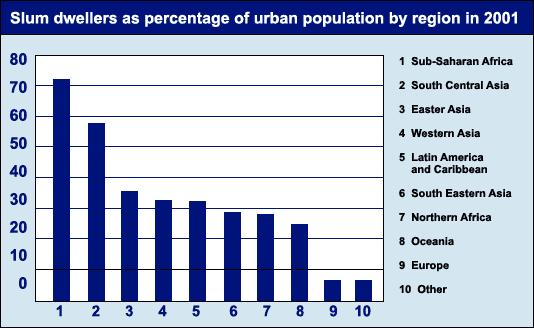
Want to learn more?
1United Nations (2009). MDG report. Retrieved July 29, 2009, from Millennium Development Goals Report Web site: http://unstats.un.org/unsd/mdg/Resources/Static/Products/Progress2009/MDG_Report_2009_En.pdf
2Department of Economic and Social Affairs (2005). Goal 7. Retrieved July 29, 2009, from Progress Towards Millennium Development Goals, 1990 – 2009 Web site: http://unstats.un.org/unsd/mdg/Resources/Attach/Products/Progress2005/goal_7.pdf
3MDG Monitor (2007). MDG monitor: tracking the millennium development goals. Retrieved July 31, 2009, from MDG Monitor Goal 7 Web site: http://www.mdgmonitor.org/goal7.cfm
4McGinley , Mark (2007). Forest biome. Retrieved July 31, 2009, from Encyclopedia of Earth Web site: http://www.eoearth.org/article/Forest_biome
5Medalye, Jacqueline and Jason A. Hubbart (2008). Water resources. Retrieved July 31, 2009, from Encyclopedia of Earth Web site:http://www.eoearth.org/article/Water_resources
6Global Water (2008, Oct. 10). Technology push program. Retrieved July 31, 2009, from Global Water Web site: http://www.globalwater.org/pdf/Technology_Push_Program_-_White_Paper_-_10-10-08.pdf
7Inderscience Publishers (2008, February 26). Cheap, Clean Drinking Water Purified Through Nanotechnology. ScienceDaily. Retrieved July 28, 2009, from http://www.sciencedaily.com/releases/2008/02/080220094656.htm
8ESRI (2009). Combining math, science, and GIS. ARCuser online, Spring 2009, Retrieved July 31, 2009, from http://www.esri.com/news/arcuser/0309/obenhaus.html
9Abdullah, Khalil. (March 17, 2008). How Do We Ensure Clean Drinking Water for All?. In Alternet.org. Retrieved 28 July, 2009, from http://www.alternet.org/water/79883/.
10 UN Millennium Project 2005. Environment and Human Well-being: A Practical Strategy. Summary version of the report of the Task Force on Environmental Sustainability. Retrieved 27 July 2009. http://www.unmillenniumproject.org/reports/tf_environment.htm.
11Food, Agriculture, Conservation, and Trade Act of 1990 (FACTA), Public Law 101-624, Title XVI, Subtitle A, Section 1603 (Government Printing Office, Washington, DC, 1990) Retrieved 30 July 2009. http://www.nationalaglawcenter.org/assets/farmbills/conservation.html.
12Sustainable Development. Retrieved July 31, 2009. http://www.esri.com/industries/environment/business/sustainable_development.html
13Shao, Guofan and Keith M. Reynolds. Computer applications in sustainable forest management. Springer, 2006.
14European Environment Agency (2009, Feb). CSI 032-Status of marine fish stocks. Retrieved August 1, 2009, from European Environment Agency Web site: http://themes.eea.europa.eu/IMS/IMS/ISpecs/ISpecification20041007132227/IAssessment1199788344728/view_content
15EUbusiness(2007, July 18). EU drought/water-scarcity strategy ‘ignores water-wasting farmers’. Retrieved August 1, 2009, from Earth News Web site: http://www.earthportal.org/news/?p=334
16Cult of Dead fish (2009, June). The World's Fish Will Die Out Within 50 Years. Retrieved Aug 1, 2009. from Cult of Dead fish Web site: http://cultofthedeadfish.blogspot.com/2009/06/world-fish-will-die-out-within-50-years.html
17Mongabay.com, (2007, December 8). Amazon deforestation rates drop 20% in 2007. Retrieved August 1, 2009, from Mongabay.com Web site: http://news.mongabay.com/2007/1208-amazon.html
18Brouchkov, I. (2003, March 24). Alternative energy sources advantages. Retrieved August 1, 2009, from Alternative Energy Sources Web site: http://www.netpilot.ca/aes/index.html
19Engber, D. (2006, November 1). How gasoline becomes CO2. Retrieved August 1, 2009, from Slate Magazine Web site: http://www.slate.com/id/2152685/
20All Hybrid Cars, (2009). Pros of hybrid vehicles. Retrieved August 1, 2009, from All Hybrid Cars Web site: http://www.allhybridcars.com/advantages-of-hybrid-cars.html
21US Dept. of Energy, (2009). Hydrogen. Retrieved August 1, 2009, from Fuel Economy Web site: http://www.fueleconomy.gov/Feg/hydrogen.shtml
22The National Academies Press (2008). Water Implications of Biofuels Production in the United States. Retrieved August 1, 2009. Web site: http://books.nap.edu/openbook.php?record_id=12039&page=37
23WWF International. Smarter fishing gear: making fishing gear more selective. Retrieved August 1, 2009, from WWF International Web site: http://www.panda.org/what_we_do/footprint/smart_fishing/bycatch/bycatch_solutions/fishing_gear/
24Westover Computing. (2008, Sep). Overfishing. Retrieved August 1, 2009, from HMS Endurance Tracking Project Website: http://www.visitandlearn.co.uk/TopicalFactfiles/Overfishing/Overfishing/tabid/397/Default.aspx
25UNDP.(2008). MDGs Goal 7: Ensure environmental sustainability . Retrieved August 1, 2009, from UNDP Website: http://www.undp.org.bt/mdg/mdg_seven.htm
26The Ozone Hole, (2007). The Montreal Protocol on Substances that Deplete the Ozone Layer. Retrieved August 2, 2009, from The Ozone Hole Web site: http://www.theozonehole.com/montreal.htm
27U.S. EPA, (2009, January 2). Significant New Alternatives Policy (SNAP) Program . Retrieved August 2, 2009, from U.S. Environmental Protection Agency Web site: http://www.epa.gov/ozone/snap/index.html
28DFID, (November 2007). Urban Poverty & Slum Dwellers. Retrieved July 31, 2009, from Department of International Development website: http://www.dfid.gov.uk/Documents/publications/mdg-factsheets/slumdwellers-factsheet.pdf
29MDG, (2009). The Millennium Development Goals Report. Retrieved August 1, 2009, from MDG Indicators website: http://mdgs.un.org/unsd/mdg/Resources/Static/Products/Progress2009/MDG_Report_2009_En.pdf
